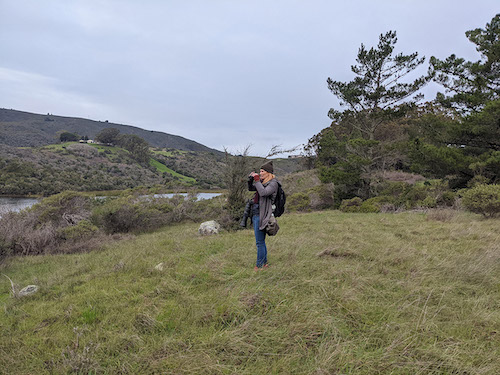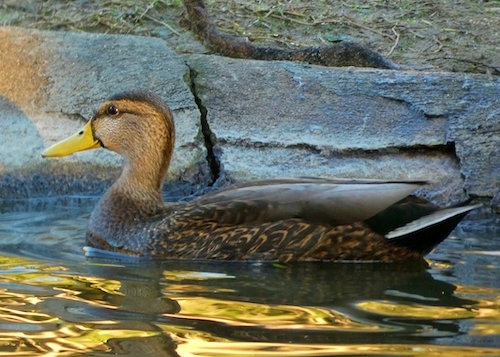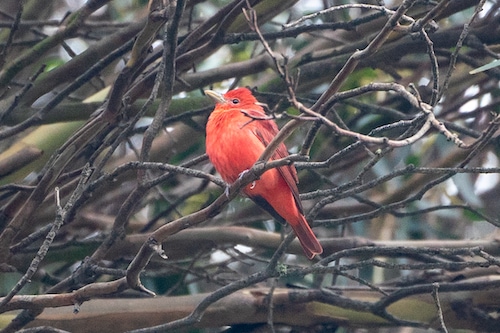2021 SF Christmas Bird Count Report
By David Assmann
San Francisco birders have been lucky – for the past fifteen years, there has been no rain on the Christmas Bird Count, and conditions have been mostly sunny, with a rare bit of fog. The December 28, 2021 count, however, was cold and cloudy, with light rain at various points throughout the day.
The weather, while reducing visibility and bird activity, did not deter 136 enthusiastic volunteers from making this one of the better Christmas Bird Counts. Participants ended up tallying more than 64,000 birds by the time the count ended – down only slightly from last year’s total on a sunny day, and well above our 10 year average.

We completed our transition to modernizing the count by reporting and compiling all data through eBird, including the documentation for rare birds. eBird’s new Trip Report feature made it much easier to consolidate information and share it with area leaders. 273 eBird checklists were submitted, an increase over last year.
By the time Count Week was over, the species tally was at least 187, and may reach 188 if the Mexican Duck, the rarest bird spotted on the count, is accepted. Illustrating the trickiness of bird identification, there is disagreement about whether or not this bird is a pure Mexican Duck, or if it also has Mallard genes. This determination will likely be made by the California Records Bird Committee, since this sighting is going to be submitted for review.

There were 28 rare species found, with nine of the eighteen areas finding a rare species. Six of the rare species were found during Count Week, but not on Count Day. New to the San Francisco Count were the Mexican Duck in Colma, and a White-winged Dove found during Count Week on Washington Street in a backyard. A Prairie Warbler found near Colma Creek in South San Francisco marked the first sighting of this species during the count since 1993.
Overall duck numbers were similar to prior years, but there was a lot of variation by species. There were only two Green-winged Teal spotted, down from 58 last year, and we missed Cinnamon Teal and Eurasian Wigeon altogether. Scaup numbers, however, were up from last year’s 611 to 1,069 this year (still well below historical numbers). We did set two count records for duck species, with eight Common Mergansers and 62 Red-breasted Mergansers. For the second year in a row, we missed White-winged Scoter (there were 1,200 counted in 1990 – a remarkable decline). Two rare geese were found – a total of seven Greater White-fronted Geese, and a count week Brant. A Redhead found in Colma was also a rare bird for the Count and a rare Long-tailed Duck added to our duck diversity.
Shorebird numbers continue to decline, mainly driven in the past year by a large drop in the number of Western Sandpipers. Some species are now down 95% from historical levels. The only bright spot this year is the number of Sanderlings increased from 1,045 to 1,602. Wandering Tattler, which has been consistently present in small numbers, was missed altogether this year. The rare Rock Sandpiper did put in an appearance at Heron’s Head for the third year in a row.
Gull numbers are increasing, and although we didn’t set any records, the number of Western Gulls almost tripled to 6,187. Loon numbers are increasing dramatically – this year we had 4,971 Red-throated Loons – almost five times as many as last year. Double-crested Cormorant numbers were down dramatically, but they could easily have been in other parts of the Bay. Brandt’s Cormorant numbers were up to 2,290. Since last year’s total of 1,805, which while not breaking our own record, was still the highest of any count in the country, we could very well have the most of this species of any count circle this year.
Rare seabirds spotted during the count included four Northern Fulmars, two Sooty/Short-tailed Shearwaters, four Marbled Murrelets, an Ancient Murrelet (count week) and three Brown Boobies (setting a record number for the count).
Interestingly, Brown Pelicans stuck around a lot longer than last year, and we set a count record with 1,702. For comparison, we counted 293 last year. Wading birds are doing very well – we had a record high 100 Black-crowned Night-Herons, a record 57 Great Blue Herons and a record 80 Snowy Egrets.
Last year we set an all-time record for the most Anna’s Hummingbirds seen in any count circle in the country ever with 1,537. This year we had a respectable 1,237. The cold gloomy weather undoubtedly played a part in numbers being down – they were less likely to be active, and counted, as a result.
Raptor numbers were similar to last year’s, which is surprising, given the weather. We had a record number of Red-Shouldered Hawks (78) and Great Horned Owls (31). There were seven Osprey, also a record, and a nice surprise, since we missed them altogether last year. Two rare Bald Eagles were found on the count. And if you’ve noticed an increasing number of American Crows, it’s not an illusion – we set an all time record with 1,710 on the count.
Swallows are becoming more prevalent in the winter. We set a record of 16 Tree Swallows and 16 Barn Swallows this year, and identified as well a Violet-Green Swallow and up to 50 swallows species that were either Tree or Violet-green Swallows. Twenty-one White-throated Swifts were counted.
Great-tailed Grackles are continuing their northward expansion. We set a new record for this species with 109. Red-masked Parakeets showed a jump in numbers this year. 509 were tallied, but that included 138 on their nightly roost, some of which could have been double counted. Even if you assume every one of the roosting birds was double counted, the remaining 371 is far higher than our previous record of 224 on a count.
In addition to the Prairie Warbler, other rare warblers for the count were three Wilson’s Warblers, three Yellow Warblers, one Black-throated Gray Warbler (count week) and a Hermit Warbler (count week). We set a new record for Orange-crowned Warblers with 88 (up from 55).
Surprisingly, other than one Oriole species during Count Week, we had no overwintering Orioles. We normally have two or three.
Sparrow numbers, while still robust, were down from last year, with the exception of Dark-eyed Juncos, which increased from 631 to 668, setting a new record for our Count.
Other rare birds found during the count included a Caspian Tern, a Tropical Kingbird, a Blue-gray Gnatcatcher, a Summer Tanager and a Western Tanager.

Heartfelt thanks to all the counters who participated this year, including those who made this their first Christmas Bird Count. Many thanks as well to Siobhan Ruck as co-compiler for the count, and to Trista Bernasconi, who joined the compiling team and spent many hours helping collect and compile data.
Many thanks to Cole Burchiel and San Francisco Baykeeper, who provided a boat for the first time in a decade for the count, and to Mark Caplin, who volunteered to be the skipper of the boat that day.
